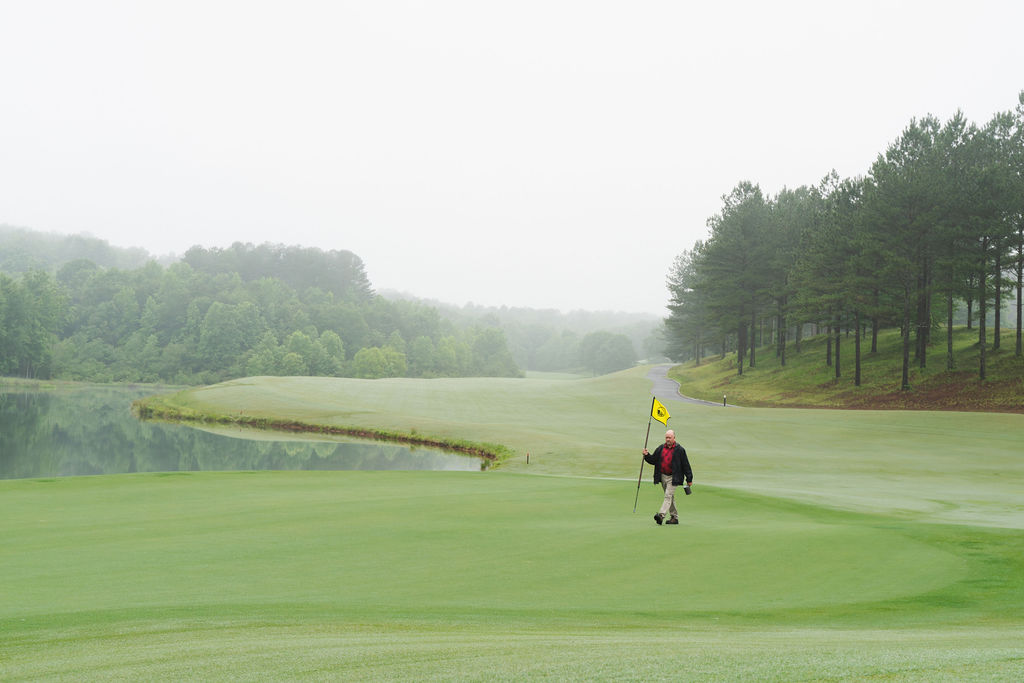Gary Player and his team took flat terrain and created one of the most preeminent, environmentally-sustainable links-style courses around.
Gary Player has seen it all. Known around the world as the Black Knight, golf’s global ambassador has traveled millions of miles throughout his storied career for competition and course design, which includes nine major championships on the regular tour, nine majors on the senior tour, and hundreds of courses to his name.
The golf world was booming in the mid-2000s. Tiger Woods was at the height of his power, inching closer to Jack Nicklaus’ all-time major record, and golf course architecture was booming with more course openings than at any other point in history. At the time, The Cliffs boasted six championship courses and set its sights on another. The Cliffs was already distinguished as a world-class collection of luxury communities and its newest layout would differentiate it through a unique links-style of play. The finished product would come years after the initial announcement, but not without immense challenges, both economical and ecological.
Unlike the other courses at The Cliffs, the land that would eventually become The Cliffs at Mountain Park was underwhelming from a prospecting standpoint.
“I vividly remember walking the site before our work commenced,” says Player. “With all I heard about The Cliffs with its mountain settings and lake contours at the other courses, we basically had nothing to work with except the river running through the property.”
That proved to be more than enough for Player and his creativity. “What can we give The Cliffs that they don’t have to be unique and different in a positive way?” Player recalls thinking at the time.
Player was faced with a similar task in his home country of South Africa at the turn of the century when he awakened an old airfield into a World Top 100 Course at The Links at Fancourt. The similarities of the environment were striking, allowing Player and his team to maximize their expertise and experience.
When the team started getting into the details and engineering of the site, it was met with seemingly endless hurdles, but the obvious solution was making the North Saluda River a key focal point in the course’s routing. But it was a double-edged sword and nearly spoiled by an expansive flood plain that restricted elevation changes and limited the team’s ability to fill earth to shape the golf course. There also is a high-pressure water vein that runs through the property and feeds the city of Greenville that is still active to this day. This meant they had to work around a strict buffer line with no grading, drainage, or piping.
Work commenced and Gary Player Design gave The Cliffs its most personal touch possible, moving its staff and design studio from Palm Beach, Florida, to a new building overlooking The Cliffs at Mountain Park site in the summer of 2008.
“The majority of the golf course was built looking out the window of what is now the Mountain Park Wellness Center “ says Jeff Lawrence, Senior Designer of the project. “I was out there every day.”
“One of the most important goals was to make the golf course sustainable as well as economically and environmentally sound,” says Lawrence. “Mr. Player is passionate about nature so incorporating native grasses, wildflowers, and plants along the river preserved and created habitats for aquatic wildlife, migratory birds, and other species to have an environment to thrive.”
According to Player, the soils on the Mountain Park site were hard to work with and extremely poor in quality. Because of this, a newer type of grass for golf courses, Diamond Zoysia, was selected for its turf and the property was never sand capped, allowing the golf course to play fast and firm, akin to traditional links golf where bump and runs are the frequent shot selection. In total, 60-70 acres of sod was placed on the grounds.
In designing the Mountain Park golf course, Player and his team paid close attention to making the fairways firm, not using too much water or fertilizer, and took full advantage of the natural characteristics of the land. What you see now beyond the fairways is not characterized as rough, but rather native grasses and waste bunkering to bolster the views of Mountain Park’s natural environment.
“Create visual interests, strategic value, and great variety,” says Player. “Mountain Park is a course designed first for members to enjoy but also provides challenges for scratch golfers as well.”
The Cliffs at Mountain Park golf course is set in a stunning wooded valley surrounded by mountains. The course is divided
by the North Saluda River and was designed with the highest environmental standards. It was carefully routed to preserve the site’s natural beauty and allow native flora, fauna, trees, and grasses to flourish. What are some of Player’s favorite holes?
“No doubt, Hole 7,” says Player. “It plays as a short par 3 and nearly every golfer will step up to the tee with a wedge in their hand. But you probably make more bogeys than birdies because of little nuances we incorporated with bunkering and a steep drop off to the left. If you miss the green, whether it’s short, long, left or right, there is no easy up and down.”
If you are wondering about the lone tree on Hole 15 acting as a land marker for the green, this is a unique design concept.
“That’s a gun site entry,” says Player. “Where you barely see what you are shooting into. That provides extra strategy and deters golfers from attempting to reach the green in two.”
The Cliffs at Mountain Park officially opened for play in 2013 to rave reviews from members and media outlets; Golf Digest even included the course on its “Best New Courses” list. A decade later, it is still a staple in the rankings and one of The Cliffs’ top-rated courses.
“Would not have done anything differently,” says Player. “With all the challenges we had, the end product was exactly what we set out to accomplish – a visually stunning, environmentally sustainable, and playable links-style golf course intertwined in a mountain setting.”
This story was featured in Cliffs Living magazine. To see more stories like this one and learn more about The Cliffs, subscribe here.





